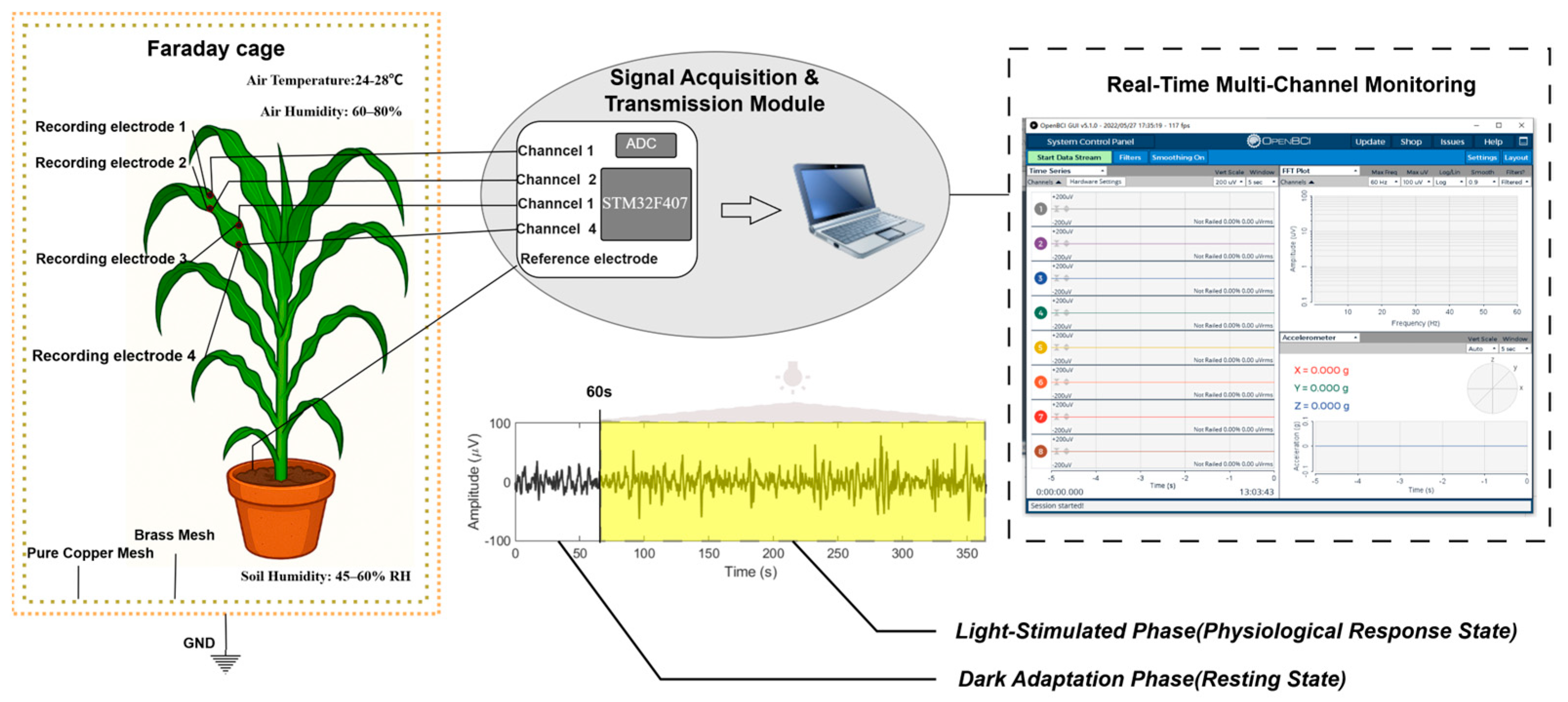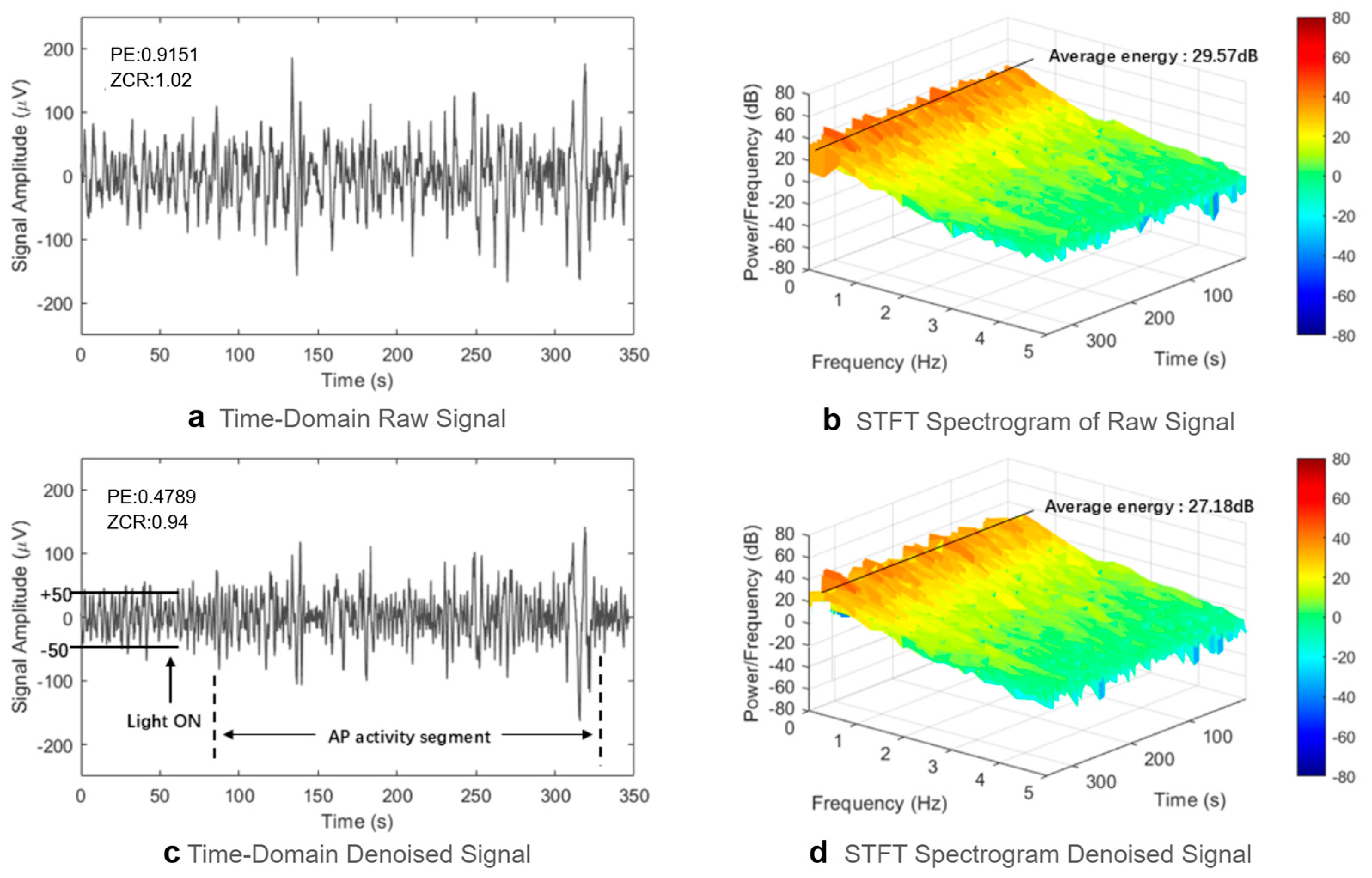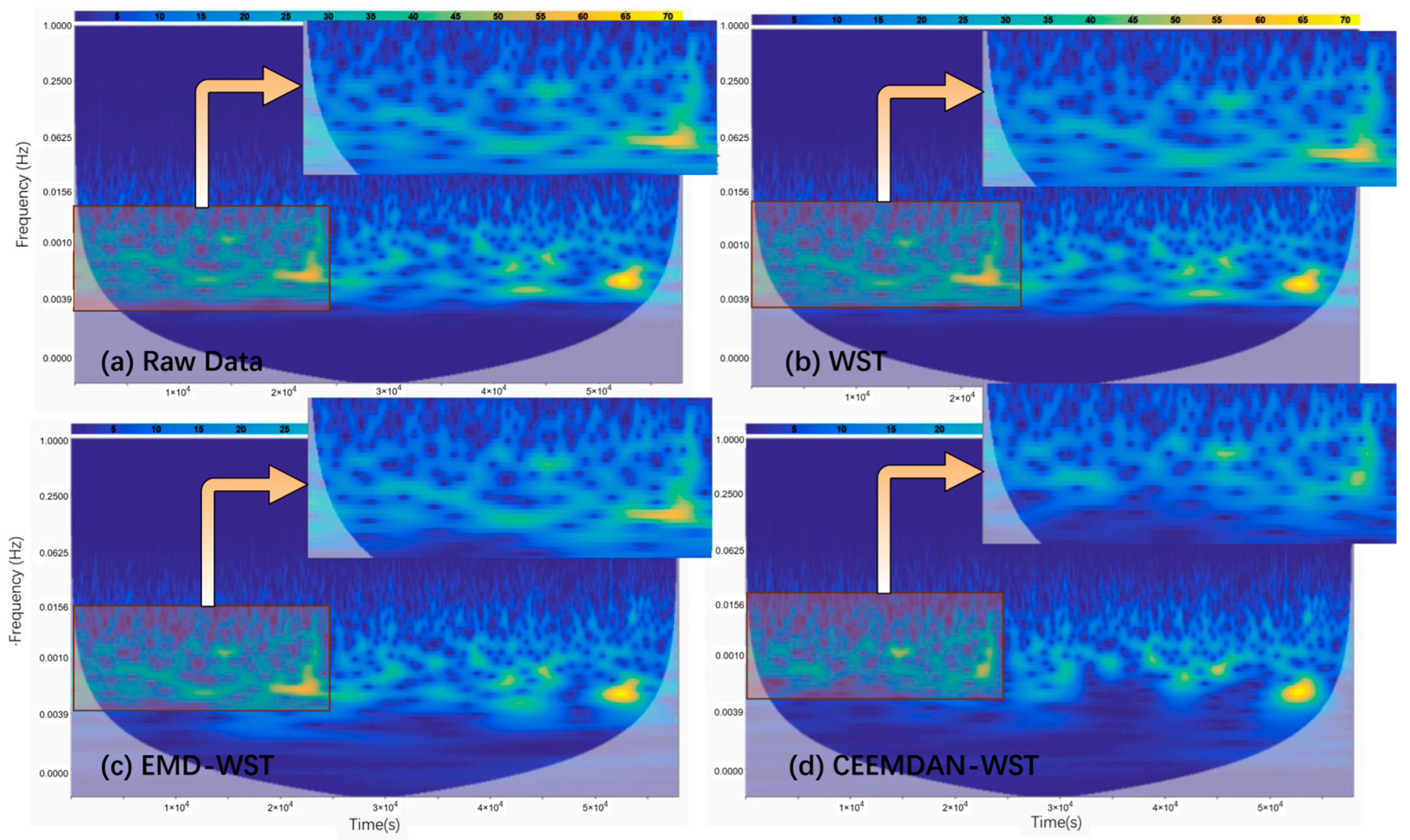Analysis of Electrical Signals in Plant Physiological Responses: A Multi-Scale Adaptive Denoising Method Based on CEEMDAN-WST
Abstract
1. Introduction
2. Materials and Methods
2.1. Experimental Materials and Data Preparation
2.1.1. Material Selection and Cultivation
2.1.2. Weak Electrical Signal Acquisition System
2.1.3. Electrical Signal Recording Under Light Stimulation
2.2. Denoising Algorithms: Principles and Implementation
2.2.1. Framework Design of the CEEMDAN-WST Denoising Method
2.2.2. Principles of the CEEMDAN-WST Algorithm
2.3. Method Comparison and Parameter Configuration
3. Results and Analysis
3.1. Denoising Process Analysis
3.1.1. Results of IMF Decomposition and Selection
3.1.2. Denoising Effect of Wavelet Soft Thresholding on Key Mid-Frequency Components
3.2. Denoising Results Analysis
3.3. Comparative Analysis of Denoising Methods
3.3.1. Time-Domain Comparative Analysis
3.3.2. Scale-Domain Comparative Analysis
4. Discussion
4.1. Selection of IMF Components
4.2. Comparison of Denoising Techniques and Application Potential
5. Conclusions
Author Contributions
Funding
Data Availability Statement
Conflicts of Interest
Abbreviations
| CEEMDAN | Complete Ensemble Empirical Mode Decomposition with Adaptive Noise |
| WST | Wavelet Soft Thresholding |
| PE | Permutation entropy |
| RMS | Root mean square |
| FWHM | Full width at half maximum |
| EMD | Empirical mode decomposition |
| EEG | Electroencephalography |
| ECG | Electrocardiography |
| ICA | Independent Component Analysis |
| PCA | Principal Component Analysis |
| IMFs | Intrinsic mode functions |
| AP | Action potential |
| ZCR | Zero-crossing rate |
| Vpp | Voltage peak-to-peak |
| PeakAmp | Peak amplitude |
| CWT | Continuous wavelet transform |
| VMD | Variational Mode Decomposition |
| EWT | Empirical Wavelet Transform |
References
- Li, J.-H.; Fan, L.-F.; Zhao, D.-J.; Zhou, Q.; Yao, J.-P.; Wang, Z.-Y.; Huang, L. Plant electrical signals: A multidisciplinary challenge. J. Plant Physiol. 2021, 261, 153418. [Google Scholar] [CrossRef] [PubMed]
- Huber, A.E.; Bauerle, T.L. Long-distance plant signaling pathways in response to multiple stressors: The gap in knowledge. J. Exp. Bot. 2016, 67, 2063–2079. [Google Scholar] [CrossRef] [PubMed]
- Mudrilov, M.; Ladeynova, M.; Grinberg, M.; Balalaeva, I.; Vodeneev, V. Electrical signaling of plants under abiotic stressors: Transmission of stimulus-specific information. Int. J. Mol. Sci. 2021, 22, 10715. [Google Scholar] [CrossRef] [PubMed]
- Xin, Y.-M. Research and Application of Online Detection Equipment for Plant Electrical Signals. Master’s Thesis, Heilongjiang Bayi Agricultural University, Daqing, China, 2020. [Google Scholar] [CrossRef]
- Shi, J.-X. Study on an In Situ Detection Method for Electrical Transmission Characteristics in Banded-Leaf Maize Using Array Electrodes. Master’s Thesis, Heilongjiang Bayi Agricultural University, Daqing, China, 2024. [Google Scholar] [CrossRef]
- Garcia-Menchaca, L.; Guerra-Sánchez, C.; Tarchoun, N.; Lebbihi, R.; Cruz-Dominguez, O.; Sifuentes-Gallardo, C.; Peréz-Martínez, J.G.; Cleva, M.; Ortega-Sigala, J.; Durán-Muñoz, H. Early-Stage Research to Characterize the Electrical Signal of Optically Stimulated Hydroponic Strawberries Using Machine Learning Techniques. Eng. Proc. 2025, 87, 44. [Google Scholar] [CrossRef]
- Wang, L.-Z.; Li, Q. Quantitative study on weak electrical signals of Bryophyllum pinnatum. J. China Jiliang Univ. 2009, 20, 195–200. [Google Scholar] [CrossRef]
- Favre, P.; Agosti, R.D. Voltage-dependent action potentials in Arabidopsis thaliana. Physiol. Plant. 2007, 131, 263–272. [Google Scholar] [CrossRef] [PubMed]
- Zhang, X.; Yu, N.; Xi, G.; Meng, X. Power spectrum analysis of maize based on wavelet de-noising. In Proceedings of the 2nd international conference on information science and engineering, Hangzhou, China, 4–6 December 2010. [Google Scholar]
- Wang, J.H.; Geng, L.H.; Zhang, C.M. Research on the weak signal detecting technique for crop water stress based on wavelet denoising. Adv. Mater. Res. 2012, 424–425, 966–970. [Google Scholar] [CrossRef]
- Peng, W. EEG preprocessing and denoising. In EEG Signal Processing and Feature Extraction; Hu, L., Zhang, Z., Eds.; Springer: Singapore, 2019; pp. 71–87. [Google Scholar] [CrossRef]
- Varady, P. Wavelet-based adaptive denoising of phonocardiographic records. In Proceedings of the 23rd Annual International Conference of the IEEE Engineering in Medicine and Biology Society, Istanbul, Turkey, 25–28 October 2001. [Google Scholar] [CrossRef]
- Liu, Z.; Bing, Z.; Tian, L.; Li, M.; Sun, Y.; Wang, Y. Research on de-noising method of plant electric signal based on EMD and wavelet threshold. In Proceedings of the 2021 7th International Conference on Control, Automation and Robotics (ICCAR), Singapore, 23–26 April 2021. [Google Scholar]
- Ren, Z.; Tian, F.; Wang, S.; Chen, S. Research on maize leaves surface action potential recognition method based on ResNet-18SE. Smart Agric. Technol. 2025, 10, 100819. [Google Scholar] [CrossRef]
- Zhang, M.; Wei, G. An integrated EMD adaptive threshold denoising method for reduction of noise in ECG. PLoS ONE 2020, 15, e0235330. [Google Scholar] [CrossRef] [PubMed]
- Khaldi, K.; Alouane, M.T.-H.; Boudraa, A.-O. A new EMD denoising approach dedicated to voiced speech signals. In Proceedings of the 2nd International Conference on Signals, Circuits and Systems, Nabeul, Tunisia, 7–9 November 2008. [Google Scholar] [CrossRef]
- Yu, J.; Zhang, Z. Research on the seismic signal denoising with the LMD and EMD method. In Proceedings of the 2017 IEEE 2nd Advanced Information Technology, Electronic and Automation Control Conference (IAEAC), Chongqing, China, 25–26 March 2017. [Google Scholar] [CrossRef]
- Cheng, J.; Li, L.; Li, C.; Liu, Y.; Liu, A.; Qian, R.; Chen, X. Remove diverse artifacts simultaneously from a single-channel EEG based on SSA and ICA: A semi-simulated study. IEEE Access 2019, 7, 60276–60289. [Google Scholar] [CrossRef]
- Rejer, I.; Górski, P. Benefits of ICA in the case of a few channel EEG. In Proceedings of the 2015 37th Annual International Conference of the IEEE Engineering in Medicine and Biology Society (EMBC), Milan, Italy, 25–29 August 2015. [Google Scholar] [CrossRef]
- Willigenburg, N.W.; Daffertshofer, A.; Kingma, I.; van Dieën, J.H. Removing ECG contamination from EMG recordings: A comparison of ICA-based and other filtering procedures. J. Electromyogr. Kinesiol. 2012, 22, 485–493. [Google Scholar] [CrossRef] [PubMed]
- Kumar, B.K. Estimation of number of levels of scaling the principal components in denoising EEG signals. Biomed. Pharmacol. J. 2021, 14, 425–433. [Google Scholar] [CrossRef]
- Ziani, S.; Suchetha, M.; Ziani, L. Enhancing signal quality: A comparative study of ICA and PCA in denoising EMG and ECG signals. In Smart Internet of Things for Environment and Healthcare; Springer: Cham, Switzerland, 2024; pp. 189–196. [Google Scholar]
- Hu, Y.; Ouyang, Y.; Wang, Z.; Yu, H.; Liu, L. Vibration signal denoising method based on CEEMDAN and its application in brake disc unbalance detection. Mech. Syst. Signal Process. 2023, 187, 109972. [Google Scholar] [CrossRef]
- Yang, Y.; Li, S.; Li, C.; He, H.; Zhang, Q. Research on ultrasonic signal processing algorithm based on CEEMDAN joint wavelet packet thresholding. Measurement 2022, 201, 111751. [Google Scholar] [CrossRef]
- Wang, Z.-Y.; Fan, L.-F.; Wang, Y.-Q.; Li, J.H. Selection of recording modes for plant surface electrical signals based on signal feature analysis. Trans. Chin. Soc. Agric. Eng. 2018, 34, 137–143. [Google Scholar] [CrossRef]
- Hedrich, R.; Salvador-Recatalà, V.; Dreyer, I. Electrical wiring and long-distance plant communication. Trends Plant Sci. 2016, 21, 376–387. [Google Scholar] [CrossRef] [PubMed]
- Volkov, A.G. Plant Electrophysiology: Theory and Methods; Springer: Berlin, Germany, 2006. [Google Scholar]
- Liao, X.-L. Denoising method of plant electrical signal based on improved wavelet threshold. Anhui Agric. Sci. 2023, 51, 4–6+20. [Google Scholar]
- Gu, J.; Tian, F.; Shi, J.; Tan, F. Noise reduction and analysis of leaf electrical signals of strap-leaved plants based on VMD-EWT. Comput. Electron. Agric. 2024, 226, 109441. [Google Scholar] [CrossRef]






| Algorithm Module | Parameter | Value |
|---|---|---|
| CEEMDAN | Noise standard deviation (Nstd) | 0.2 |
| Noise ensemble size (NR) | 100 | |
| Maximum iterations (MaxIter) | 100 | |
| SNR mode (SNRFlag) | 1 | |
| WST | Wavelet type | db4 |
| Decomposition level | 4 | |
| Thresholding method | Sofe (S) | |
| Threshold selection rule | Heuristic SURE (heursure) |
| Dominant Frequency (Hz) | Spectral Centroid (Hz) | Spectral Spread (Hz2) | Spectral Entropy | Permutation Entropy | Cumulative Energy (0–10 Hz) (%) | RMS Bandwidth (Hz) | |
|---|---|---|---|---|---|---|---|
| IMF1 | 62.04 | 57.92 | 233.273 | 13.682 | 0.9971 | 0.61 | 59.90 |
| IMF2 | 32.45 | 29.10 | 57.989 | 12.777 | 0.9123 | 0.89 | 30.08 |
| IMF3 | 17.25 | 17.15 | 16.328 | 11.854 | 0.7768 | 2.95 | 17.62 |
| IMF4 | 9.95 | 9.94 | 6.097 | 11.161 | 0.6607 | 53.26 | 10.24 |
| IMF5 | 5.00 | 5.37 | 2.315 | 10.434 | 0.5664 | 99.62 | 5.59 |
| IMF6 | 1.51 | 2.27 | 0.744 | 9.576 | 0.4954 | 100.00 | 2.43 |
| IMF7 | 0.72 | 0.93 | 0.158 | 8.423 | 0.4472 | 100.00 | 1.01 |
| IMF8 | 0.47 | 0.48 | 0.040 | 7.370 | 0.4167 | 100.00 | 0.52 |
| IMF9 | 0.23 | 0.24 | 0.112 | 6.350 | 0.4019 | 100.00 | 0.41 |
| IMF10 | 0.13 | 0.13 | 0.055 | 4.6739 | 0.3919 | 100.00 | 0.27 |
| IMF11 | 0.08 | 0.08 | 0.072 | 4.013 | 0.3895 | 100.00 | 0.28 |
| IMF12 | 0.04 | 0.04 | 0.015 | 3.083 | 0.3895 | 100.00 | 0.13 |
| IMF13 | 0.01 | 0.02 | 0.0005 | 3.023 | 0.3884 | 100.00 | 0.03 |
| IMF14 | 0.01 | 0.01 | 0.0012 | 2.298 | 0.3874 | 100.00 | 0.03 |
| IMF15 | 0.00 | 0.01 | 0.0242 | 1.7674 | 0.3852 | 100.00 | 0.01 |
| IMF16 | 0.00 | 0.00 | 0.0173 | 0.762 | 0.3861 | 100.00 | 0.01 |
| Method | PE | Vpp | RMS | Spikes | PeakAmp | FWHM |
|---|---|---|---|---|---|---|
| Raw Data | 0.9151 | 219.37 | 38.81 | 4 | 186.36 | 0.078264 |
| WST | 0.4830 | 217.78 | 38.80 | 2 | 185.51 | 0.70239 |
| EMD-WST | 0.4812 | 211.91 | 38.17 | 1 | 169.51 | 0.66942 |
| CEEMDAN-WST | 0.4789 | 157.34 | 27.59 | 0 | 118.54 | 0.74708 |
| Method | Total Energy (×109) | Scale Centroid (Hz) | Time Energy Concentration (×10−5) | Scale Bandwidth (Hz) |
|---|---|---|---|---|
| Raw Data | 1.438 | 0.44084 | 7.5459 | 0.38715 |
| WST | 1.4366 | 0.43606 | 7.5514 | 0.34977 |
| EMD-WST | 1.4367 | 0.43619 | 7.5344 | 0.34996 |
| CEEMDAN-WST | 1.3045 | 0.45617 | 8.4790 | 0.35998 |
Disclaimer/Publisher’s Note: The statements, opinions and data contained in all publications are solely those of the individual author(s) and contributor(s) and not of MDPI and/or the editor(s). MDPI and/or the editor(s) disclaim responsibility for any injury to people or property resulting from any ideas, methods, instructions or products referred to in the content. |
© 2025 by the authors. Licensee MDPI, Basel, Switzerland. This article is an open access article distributed under the terms and conditions of the Creative Commons Attribution (CC BY) license (https://creativecommons.org/licenses/by/4.0/).
Share and Cite
Liu, Z.; Tian, F.; Tan, F. Analysis of Electrical Signals in Plant Physiological Responses: A Multi-Scale Adaptive Denoising Method Based on CEEMDAN-WST. Agriculture 2025, 15, 2269. https://doi.org/10.3390/agriculture15212269
Liu Z, Tian F, Tan F. Analysis of Electrical Signals in Plant Physiological Responses: A Multi-Scale Adaptive Denoising Method Based on CEEMDAN-WST. Agriculture. 2025; 15(21):2269. https://doi.org/10.3390/agriculture15212269
Chicago/Turabian StyleLiu, Zihan, Fangming Tian, and Feng Tan. 2025. "Analysis of Electrical Signals in Plant Physiological Responses: A Multi-Scale Adaptive Denoising Method Based on CEEMDAN-WST" Agriculture 15, no. 21: 2269. https://doi.org/10.3390/agriculture15212269
APA StyleLiu, Z., Tian, F., & Tan, F. (2025). Analysis of Electrical Signals in Plant Physiological Responses: A Multi-Scale Adaptive Denoising Method Based on CEEMDAN-WST. Agriculture, 15(21), 2269. https://doi.org/10.3390/agriculture15212269






